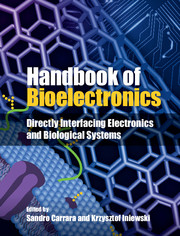Book contents
- Frontmatter
- Contents
- List of Contributors
- 1 What is bioelectronics?
- Part I Electronic components
- Part II Biosensors
- Part III Fuel cells
- Part IV Biomimetic systems
- Part V Bionics
- Part VI Brain interfaces
- 27 Introduction to brain–machine interfaces
- 28 ECG technology for the brain–machine interface
- 29 Reducing the implant footprint: low-area neural recording
- 30 Electrical stimulation
- 31 Biological channel modeling and implantable UWB antenna design for neural recording systems
- 32 Intracranial epilepsy monitoring using wireless neural recording systems
- 33 Low-power building blocks for neural recording systems
- 34 CMOS circuits for intracellular brain–machine interfaces
- Part VII Lab-on-a-chip
- Part VIII Future perspectives
- Index
- References
27 - Introduction to brain–machine interfaces
from Part VI - Brain interfaces
Published online by Cambridge University Press: 05 September 2015
- Frontmatter
- Contents
- List of Contributors
- 1 What is bioelectronics?
- Part I Electronic components
- Part II Biosensors
- Part III Fuel cells
- Part IV Biomimetic systems
- Part V Bionics
- Part VI Brain interfaces
- 27 Introduction to brain–machine interfaces
- 28 ECG technology for the brain–machine interface
- 29 Reducing the implant footprint: low-area neural recording
- 30 Electrical stimulation
- 31 Biological channel modeling and implantable UWB antenna design for neural recording systems
- 32 Intracranial epilepsy monitoring using wireless neural recording systems
- 33 Low-power building blocks for neural recording systems
- 34 CMOS circuits for intracellular brain–machine interfaces
- Part VII Lab-on-a-chip
- Part VIII Future perspectives
- Index
- References
Summary
In the first demonstration of human brain-to-brain control, a scientist wearing an electrical brain-signal reading cap triggered motion in his colleague across campus [1]. While research on brain–machine interfacing has been going on for years, this recent demonstration represents an impressive signal of how advanced technology has become. Using electrical brain recordings and a form of magnetic stimulation, one researcher sent a brain signal to another on the other side of the University of Washington campus, causing the recipient’s finger to move on a keyboard. Similarly, other researchers have demonstrated brain-to-brain communication between two rats, or between a human and a rat.
The technologies used by the researchers for recording and stimulating the brain are both well known. Electroencephalography (EEG) is routinely used by clinicians and researchers to record brain activity non-invasively from the scalp and is discussed in the first chapter of this part of the book. Transcranial magnetic stimulation, on the other hand, is a non-invasive way of delivering stimulation to the brain to elicit a response. In the experiment mentioned above, the stimulating magnetic coil was placed directly over the brain region that controls a person’s right hand. By activating these neurons, the stimulation “convinced” the brain that it needed to move the right hand.
- Type
- Chapter
- Information
- Handbook of BioelectronicsDirectly Interfacing Electronics and Biological Systems, pp. 341 - 343Publisher: Cambridge University PressPrint publication year: 2015



